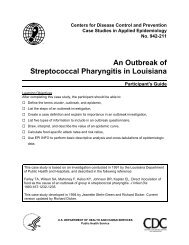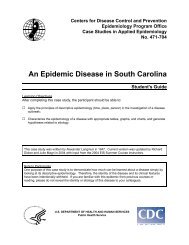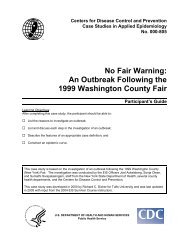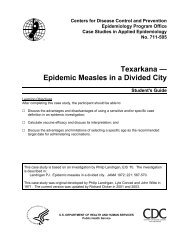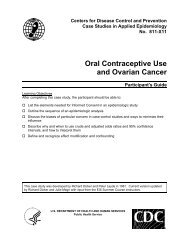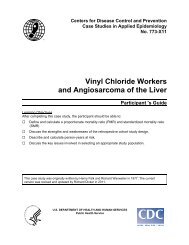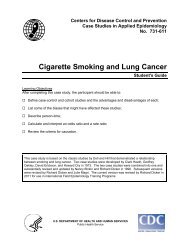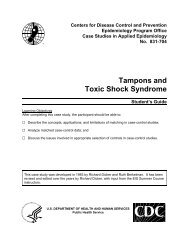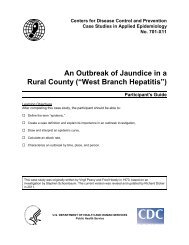An effect of H1N1 pandemic monovalent vaccines on the ... - Library
An effect of H1N1 pandemic monovalent vaccines on the ... - Library
An effect of H1N1 pandemic monovalent vaccines on the ... - Library
You also want an ePaper? Increase the reach of your titles
YUMPU automatically turns print PDFs into web optimized ePapers that Google loves.
The <str<strong>on</strong>g>effect</str<strong>on</strong>g>s <str<strong>on</strong>g>of</str<strong>on</strong>g> <str<strong>on</strong>g>H1N1</str<strong>on</strong>g> <str<strong>on</strong>g>pandemic</str<strong>on</strong>g><str<strong>on</strong>g>m<strong>on</strong>ovalent</str<strong>on</strong>g> vaccine <strong>on</strong> an influenzaoutbreak in a pris<strong>on</strong>, Thailand, 2010Hirunwut Praekunatham, Karnjanapibo<strong>on</strong>w<strong>on</strong>g A., WannaW., Watcharatarad<strong>on</strong> P., Sabuythae V., Panitchakit J.,Rungsawasd N., Kasem J., W<strong>on</strong>gchana T., Bura M., WankeawT., Inpen Y., Bunkern V., Khemth<strong>on</strong>g K., Titsuwan S.,Phetsindechakul N., Juntarawimo<strong>on</strong> P., Sa<strong>on</strong>uam P.,Chuenj<strong>on</strong>gkolkul P., Iamsirithaworn S.Joint Investigati<strong>on</strong> Team: Treatment Unit <str<strong>on</strong>g>of</str<strong>on</strong>g> Pris<strong>on</strong>, Sawan PracharakHospital, Mueang Nakh<strong>on</strong> Sawan District Health Office, Nakh<strong>on</strong> SawanProvincial Health Office, Office <str<strong>on</strong>g>of</str<strong>on</strong>g> Disease Preventi<strong>on</strong> and C<strong>on</strong>trol 8(Nakh<strong>on</strong> Sawan) and Bureau <str<strong>on</strong>g>of</str<strong>on</strong>g> Epidemiology, MOPH, Thailand
Background <str<strong>on</strong>g>of</str<strong>on</strong>g> Pris<strong>on</strong> N• On Aug 29, 2010, <strong>the</strong> 2009<str<strong>on</strong>g>H1N1</str<strong>on</strong>g> influenza outbreak inmale pris<strong>on</strong>ers was detected• Early August, approximately1/2 <str<strong>on</strong>g>of</str<strong>on</strong>g> female & 1/3 <str<strong>on</strong>g>of</str<strong>on</strong>g> malepris<strong>on</strong>ers received 2009 <str<strong>on</strong>g>H1N1</str<strong>on</strong>g><str<strong>on</strong>g>m<strong>on</strong>ovalent</str<strong>on</strong>g> vaccineVaccinati<strong>on</strong> period: Aug 2-6Outbreak detected1 7 14 21 28 Aug
2009 <str<strong>on</strong>g>H1N1</str<strong>on</strong>g> <str<strong>on</strong>g>m<strong>on</strong>ovalent</str<strong>on</strong>g> vaccine in Thailand• 2 milli<strong>on</strong> doses purchased anddistributed in early 2010• Vaccinati<strong>on</strong> target groups:o Fr<strong>on</strong>t-line HCWso Pregnant womeno Obese populati<strong>on</strong>o Handicappedo Chr<strong>on</strong>ic diseasesPanenza: A/California/7/2009 (<str<strong>on</strong>g>H1N1</str<strong>on</strong>g>) -like strain NYMC X – 179A• <str<strong>on</strong>g>H1N1</str<strong>on</strong>g> <str<strong>on</strong>g>m<strong>on</strong>ovalent</str<strong>on</strong>g> vaccine <str<strong>on</strong>g>effect</str<strong>on</strong>g>iveness studieso 72% in England & Scotland (Hardelid P, et al.)o 87.3% in Beijing (Wu J., et al.)3
Objectives• To c<strong>on</strong>firm diagnosis and determine <strong>the</strong>extent <str<strong>on</strong>g>of</str<strong>on</strong>g> outbreak• To identify risk factors <str<strong>on</strong>g>of</str<strong>on</strong>g> infecti<strong>on</strong>s• To evaluate vaccine <str<strong>on</strong>g>effect</str<strong>on</strong>g>iveness am<strong>on</strong>g malepris<strong>on</strong>ers
Methods
Descriptive study• Reviewed log book, lab reports, antiviral treatmentand vaccine records in <strong>the</strong> pris<strong>on</strong>• Active case finding in male and female pris<strong>on</strong>ers• Case definiti<strong>on</strong>:– Influenza-like illness (ILI): A pris<strong>on</strong>er who had cough orsore throat AND fever ≥ 37.8°C between Aug 20 andSep 8, 2010– C<strong>on</strong>firmed 2009 <str<strong>on</strong>g>H1N1</str<strong>on</strong>g> influenza case: A pris<strong>on</strong>er whohad• throat swab positive for 2009 <str<strong>on</strong>g>H1N1</str<strong>on</strong>g> influenza by RT-PCR or• ≥ 4-fold rise <str<strong>on</strong>g>of</str<strong>on</strong>g> antibody titer by Hemagglutinati<strong>on</strong> Inhibiti<strong>on</strong>(HI) test
<str<strong>on</strong>g>An</str<strong>on</strong>g>alytic study: Retrospective cohort #1• To identify possible risk/protective factors2,482 Male pris<strong>on</strong>ers in 5 wardsWards with a high attack rate933 Male pris<strong>on</strong>ers from wards 2 and 4688 (73.7%) Interviewed by a structured questi<strong>on</strong>naire• Statistical analysis:• Crude analysis: Risk ratio with 95% c<strong>on</strong>fidence interval• Multiple logistic regressi<strong>on</strong>: Adjusted OR with 95%CI
<str<strong>on</strong>g>An</str<strong>on</strong>g>alytic study: Retrospective cohort #2• To study vaccine <str<strong>on</strong>g>effect</str<strong>on</strong>g>iveness (using HI test)<str<strong>on</strong>g>H1N1</str<strong>on</strong>g> vaccinated group50 vaccinees for1. Paired serum for HI test2. ILI symptoms100 Male pris<strong>on</strong>ers sub-sampled from<strong>the</strong> retrospective cohort #1Randomly selected• Paired serum ≥ 4-fold rise 2009 <str<strong>on</strong>g>H1N1</str<strong>on</strong>g> influenza infecti<strong>on</strong>• Statistical analysis:Risk ratio (RR) with 95% CIN<strong>on</strong>-vaccinated group50 n<strong>on</strong>-vaccinated for1. Paired serum for HI test2. ILI symptomsVaccine <str<strong>on</strong>g>effect</str<strong>on</strong>g>iveness = (1 – RR) x 100
Result: descriptive study
Number <str<strong>on</strong>g>of</str<strong>on</strong>g> ILI and c<strong>on</strong>firmed 2009 <str<strong>on</strong>g>H1N1</str<strong>on</strong>g> cases in malepris<strong>on</strong>ers (N=216), pris<strong>on</strong> N, Aug 20-Sep 8, 2010Number <str<strong>on</strong>g>of</str<strong>on</strong>g> casesInvestigati<strong>on</strong>began60 • % <str<strong>on</strong>g>of</str<strong>on</strong>g> ILI: 216/2,482 (8.7%)C<strong>on</strong>firmed• C<strong>on</strong>firmed 2009 <str<strong>on</strong>g>H1N1</str<strong>on</strong>g>:65/126 (51.6%)Outbreakdetected2009 <str<strong>on</strong>g>H1N1</str<strong>on</strong>g>ILI4020• Hospitalizati<strong>on</strong>: 2/216 (0.9%)• Median age: 27 yrs (18-61)Outbreakstarted0Vaccinati<strong>on</strong>Note: Data from treatment unitDate <str<strong>on</strong>g>of</str<strong>on</strong>g> diagnosis
Map <str<strong>on</strong>g>of</str<strong>on</strong>g> pris<strong>on</strong>er wards and attack ratesM5M1M2M4M3Cafeteria<str<strong>on</strong>g>of</str<strong>on</strong>g>ficeGate151050%Attack rate by ward7.2 %13.4 %9.8 %6.0 % 9.0%0.5 %M1 M2 M3 M4 M5 FFcafeteriaMFPris<strong>on</strong> for malePris<strong>on</strong> for female
2009 <str<strong>on</strong>g>H1N1</str<strong>on</strong>g> <str<strong>on</strong>g>m<strong>on</strong>ovalent</str<strong>on</strong>g> vaccine coverage(Vaccines administered during Aug 2 - 6, 2010)Female pris<strong>on</strong>er54 %Male pris<strong>on</strong>er33 %50%40302010033%32%0 20 40 60 80 10045 %28 %42 %M1 M2 M3 M4 M5%Coverage <str<strong>on</strong>g>of</str<strong>on</strong>g> 2009<str<strong>on</strong>g>H1N1</str<strong>on</strong>g> <str<strong>on</strong>g>m<strong>on</strong>ovalent</str<strong>on</strong>g>vaccine by male ward
Correlati<strong>on</strong> between <str<strong>on</strong>g>H1N1</str<strong>on</strong>g> influenza vaccinecoverage and ward-specific attack rate <str<strong>on</strong>g>of</str<strong>on</strong>g> ILIAR <str<strong>on</strong>g>of</str<strong>on</strong>g> ILI (%)1510500 10 20 30 40 50 60Vaccine coverage (%)Correlati<strong>on</strong> coefficient = -0.93 (p=0.02)
Result: <str<strong>on</strong>g>An</str<strong>on</strong>g>alytic study
Multivariate analysis:Retrospective cohort #1 (N=688)Factor Crude RR 95% CIReceived 2009<str<strong>on</strong>g>H1N1</str<strong>on</strong>g> vaccineAge group< 25 years25-39 years≥ 40 yearsAdjustedOR95% CI0.52 0.27-0.98 0.51 0.26-1.021.491.1510.67-3.310.55-2.43Ref1.421.1110.59-3.420.49-2.49RefExposed to ARIpers<strong>on</strong>s1.61 0.98-2.63 1.56 0.90-2.71Sharing spo<strong>on</strong> 2.05 1.19-3.53 1.42 1.06-1.92
Retrospective cohort #2 for<str<strong>on</strong>g>H1N1</str<strong>on</strong>g> vaccine <str<strong>on</strong>g>effect</str<strong>on</strong>g>iveness study2009 <str<strong>on</strong>g>H1N1</str<strong>on</strong>g>vaccinated (n=50)N<strong>on</strong>-vaccinated(n=50)Paired serumtested (n=49)Loss t<str<strong>on</strong>g>of</str<strong>on</strong>g>ollow up(n=1)Paired serumtested (n=47)Loss t<str<strong>on</strong>g>of</str<strong>on</strong>g>ollow up(n=3)Yes4-fold riseNo4-fold rise6 43 29 18Yes12.2% 61.7%No
Effectiveness <str<strong>on</strong>g>of</str<strong>on</strong>g> <str<strong>on</strong>g>H1N1</str<strong>on</strong>g> <str<strong>on</strong>g>m<strong>on</strong>ovalent</str<strong>on</strong>g> vaccine2009 <str<strong>on</strong>g>H1N1</str<strong>on</strong>g>vaccinati<strong>on</strong><str<strong>on</strong>g>H1N1</str<strong>on</strong>g> Infecti<strong>on</strong>(4-fold rise)*ILI symptoms*Yes No Yes NoYes 6 43 4 45No 29 18 7 40Relative risk (95% CI) 0.20 (0.09, 0.43) 0.55 (0.17, 1.75)Vaccine <str<strong>on</strong>g>effect</str<strong>on</strong>g>iveness (preventing infecti<strong>on</strong>) = 80% (57%, 91%)Vaccine <str<strong>on</strong>g>effect</str<strong>on</strong>g>iveness (preventing ILI) = 45% (-75%, 83%)*from 96 male pris<strong>on</strong>ers who had paired serum
Discussi<strong>on</strong>
Lower attack rates in female than male wards• Incidence <str<strong>on</strong>g>of</str<strong>on</strong>g> 2009 <str<strong>on</strong>g>H1N1</str<strong>on</strong>g> influenza was higherin male pris<strong>on</strong>ers than female pris<strong>on</strong>ers:– Delay in case detecti<strong>on</strong> and inadequate c<strong>on</strong>trolmeasures in males– Higher coverage <str<strong>on</strong>g>of</str<strong>on</strong>g> <str<strong>on</strong>g>H1N1</str<strong>on</strong>g> <str<strong>on</strong>g>m<strong>on</strong>ovalent</str<strong>on</strong>g> vaccine infemales than males (54% vs. 33%)– Better pers<strong>on</strong>al hygiene in female pris<strong>on</strong>ers
Effects <str<strong>on</strong>g>of</str<strong>on</strong>g> <strong>the</strong> 2009 <str<strong>on</strong>g>H1N1</str<strong>on</strong>g> <str<strong>on</strong>g>m<strong>on</strong>ovalent</str<strong>on</strong>g> vaccine• 33% <str<strong>on</strong>g>of</str<strong>on</strong>g> vaccine coverage might not be enoughfor preventing <str<strong>on</strong>g>H1N1</str<strong>on</strong>g> epidemic in a pris<strong>on</strong> setting• Vaccine c<strong>on</strong>tributed to lower attack rate (8.7%)compared to o<strong>the</strong>r 4 pris<strong>on</strong> outbreaks inThailand (ILI attack rates: 10.3-26.6%)• 54% vaccine coverage in female ward might be afactor <str<strong>on</strong>g>of</str<strong>on</strong>g> limited transmissi<strong>on</strong>s <str<strong>on</strong>g>of</str<strong>on</strong>g> <str<strong>on</strong>g>H1N1</str<strong>on</strong>g> virus infemale pris<strong>on</strong>ers reach a herd immunity level
C<strong>on</strong>clusi<strong>on</strong>s• The 2009 <str<strong>on</strong>g>H1N1</str<strong>on</strong>g> influenza outbreak in Pris<strong>on</strong> Nmainly affected male pris<strong>on</strong>ers• The 2009 <str<strong>on</strong>g>H1N1</str<strong>on</strong>g> <str<strong>on</strong>g>m<strong>on</strong>ovalent</str<strong>on</strong>g> vaccine was less than50% <str<strong>on</strong>g>effect</str<strong>on</strong>g>ive in preventing ILI symptoms in thisoutbreak• The <str<strong>on</strong>g>vaccines</str<strong>on</strong>g> could significantly reduce 2009 <str<strong>on</strong>g>H1N1</str<strong>on</strong>g>infecti<strong>on</strong> (80%) and resulted in limited transmissi<strong>on</strong>and low ILI attack rate am<strong>on</strong>g pris<strong>on</strong>ers
Public health implicati<strong>on</strong>s• Advocate influenza vaccinati<strong>on</strong> policy to pris<strong>on</strong>management• At least 50% <str<strong>on</strong>g>of</str<strong>on</strong>g> vaccine coverage is needed forpreventing an outbreak in a pris<strong>on</strong> setting• Fur<strong>the</strong>r study <strong>the</strong> immunogenicity <str<strong>on</strong>g>of</str<strong>on</strong>g> <strong>the</strong> <str<strong>on</strong>g>H1N1</str<strong>on</strong>g><str<strong>on</strong>g>m<strong>on</strong>ovalent</str<strong>on</strong>g> vaccine sold in Thailand• Promote pers<strong>on</strong>al hygiene practice and provideadequate eating utensils to all pris<strong>on</strong>ers
Acknowledgements• Director, <str<strong>on</strong>g>of</str<strong>on</strong>g>ficers and pris<strong>on</strong>ers in Pris<strong>on</strong> N• District Health Office, Mueang, Nakh<strong>on</strong>sawan• Nakh<strong>on</strong>sawan Provincial Health Office• Office <str<strong>on</strong>g>of</str<strong>on</strong>g> Disease Preventi<strong>on</strong> and C<strong>on</strong>trol 8,Nakh<strong>on</strong>sawan• Sawan Pracharak Hospital• Borommaratchach<strong>on</strong>nani Sawan Pracharak NursingCollege• Department <str<strong>on</strong>g>of</str<strong>on</strong>g> Microbiology, Faculty <str<strong>on</strong>g>of</str<strong>on</strong>g> Medicine atSiriraj Hospital• Regi<strong>on</strong>al laboratory <str<strong>on</strong>g>of</str<strong>on</strong>g> <strong>the</strong> Department <str<strong>on</strong>g>of</str<strong>on</strong>g> MedicalSciences• Ms. Cheevarat Buakhao




